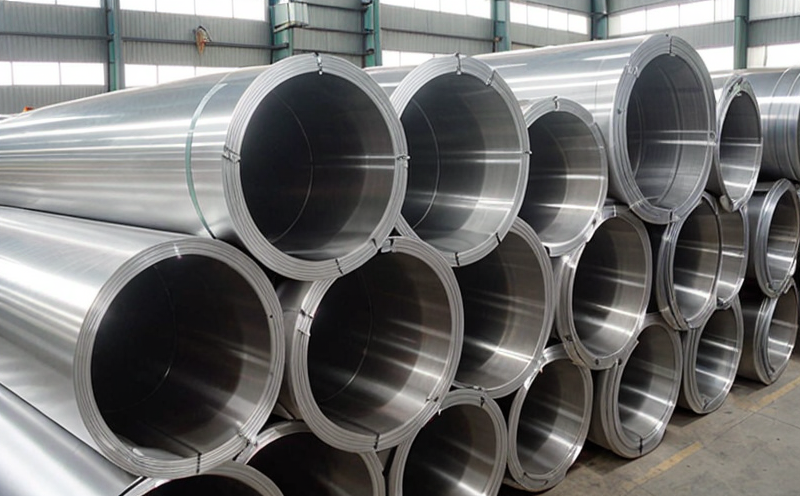ISO 4892-2 UV Resistance Testing (Artificial Weathering)
The ISO 4892-2 standard specifies a method of testing materials to determine their resistance to the effects of ultraviolet radiation. This form of artificial weathering simulates the damaging impact that sunlight has on materials, particularly in outdoor environments such as those experienced by marine and ship equipment. In the context of marine & ship equipment testing for aluminium materials, this test is crucial to ensure that the materials used can withstand the harsh conditions they will be exposed to over their operational life.
Aluminium, being a lightweight yet durable metal, is widely used in the construction of various components in marine and ship equipment. However, exposure to UV radiation can cause significant degradation, leading to decreased strength, increased brittleness, and eventual failure. The ISO 4892-2 test aims to replicate this environmental stress in a laboratory setting to predict how materials will perform under real-world conditions.
The testing process involves exposing the aluminium specimens to controlled ultraviolet radiation from artificial light sources such as xenon arc lamps. These lamps simulate sunlight, including both UV-A and UV-B rays, which are known to cause material degradation. The test specimens are placed in a chamber where the intensity, duration, and spectrum of the light can be precisely controlled. This ensures that the results are consistent and repeatable.
The temperature conditions during the testing also play a crucial role in simulating real-world exposure. The standard allows for different temperature ranges to be used, depending on the expected environmental conditions under which the materials will operate. For marine equipment, it is common to simulate temperatures ranging from 50°C to 65°C.
Specimen preparation before testing involves selecting a representative sample of the aluminium material that will undergo the test. The samples are cut into standard shapes and sizes to ensure uniformity across all specimens being tested. This step ensures that any observed changes in properties can be attributed to UV exposure rather than differences in the samples themselves.
After completing the artificial weathering process, the specimens are evaluated for various physical property changes. These include color change, loss of gloss, and dimensional stability. Changes in tensile strength, elongation at break, and impact resistance are also assessed. The test results provide a comprehensive understanding of how well the aluminium materials can withstand UV exposure.
The testing process is highly technical and requires precise control over environmental factors such as light intensity, temperature, humidity, and exposure duration. The standard specifies detailed procedures to ensure that all tests are conducted under consistent conditions. This consistency allows for accurate comparison between different samples or batches of material.
Understanding the results from ISO 4892-2 testing is essential for quality managers and compliance officers in ensuring that materials meet specified standards. For R&D engineers, this test provides valuable data to refine formulations and improve material properties. Procurement professionals can use these results to select suppliers who provide materials capable of meeting rigorous UV resistance requirements.
The ISO 4892-2 standard is widely recognized for its reliability in predicting the long-term performance of materials exposed to sunlight. By using this method, manufacturers can ensure that their products will maintain their integrity and functionality over extended periods, especially in demanding environments like those found in marine applications.
Applied Standards
The ISO 4892-2 standard is the internationally recognized methodology for testing materials under ultraviolet radiation. This standard has been adopted by numerous organizations and industries worldwide due to its robustness and accuracy. Organizations such as ASTM, EN, and IEC also provide additional guidance on similar topics, but the primary focus remains on ISO 4892-2.
ISO 4892-1 covers general principles and test methods for UV resistance testing in various environments. While not directly applicable to artificial weathering tests like ISO 4892-2, it provides foundational knowledge that complements the specific requirements of this standard.
For marine & ship equipment testing specifically, compliance with ISO 4892-2 ensures that the materials used meet stringent quality and reliability criteria. This is critical in industries where material failure can lead to significant safety concerns or costly repairs.
Industry Applications
Cargo containers: Exposure to UV radiation from direct sunlight can cause paint degradation, leading to premature aging of the container's surface. ISO 4892-2 testing helps manufacturers ensure that their coatings maintain integrity.
Fuel tanks: In marine environments, fuel tanks are subject to constant exposure to ultraviolet light and moisture. Testing materials using this standard ensures they can withstand these harsh conditions without deteriorating over time.
Deck furniture: Outdoor furniture used on ships is frequently exposed to UV radiation, which can cause cracking or splitting of the materials. ISO 4892-2 testing helps in selecting durable materials that will maintain their appearance and functionality.
Propellers: Propeller blades are subject to extreme conditions, including UV exposure from sunlight. Ensuring propellers withstand these stresses is crucial for maintaining vessel performance and safety.
The results of ISO 4892-2 testing can help manufacturers in the design phase by providing insights into material selection and formulation. This ensures that materials are not only resistant to UV radiation but also maintain other critical properties such as strength, flexibility, and color stability.
Quality and Reliability Assurance
Consistent Quality: By using ISO 4892-2 testing, manufacturers can ensure that all batches of aluminium used in marine equipment meet the same quality standards. This consistency is essential for maintaining product reliability.
Safety Compliance: Many regulations require materials to withstand UV exposure without significant degradation. Testing with this standard ensures compliance with these regulatory requirements.
Reduction of Environmental Impact: By ensuring that materials do not degrade over time, manufacturers can reduce the need for frequent replacements, which in turn decreases waste and environmental impact.
The testing process is critical to maintaining high-quality standards across the industry. It helps identify potential issues early on in the product development cycle, allowing for necessary adjustments before production begins. This proactive approach not only enhances material performance but also improves overall product reliability and safety.





